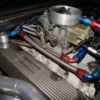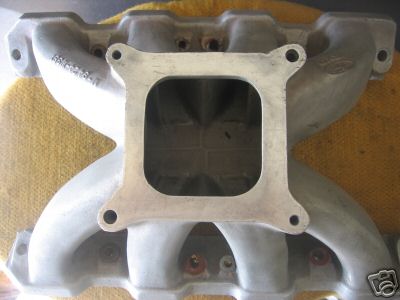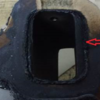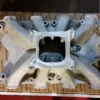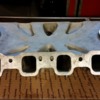The A3 heads are nice heads. They were Ford's first aluminum racing heads, replacing the cast iron production 4V heads. They are a historically interesting second step improvement in Cleveland heads (the first step improvement was the D3ZE iron street heads). The difference between the A3 heads & D3ZE heads makes folks scratch their heads to this day, because they don't exhibit a unified concept. One was more in tuned with folks dealing with a 4" bore. The other was more in tuned with drag racers who had access to Bud Moore's large bore blocks (I think

).
It is possible to make big horsepower with the A3 heads. There is at least one other intake manifold option that I hadn't previously mentioned in the post quoted by EH Pantera (Mark). That is the Scott Cook dual plane manifold. Its a close match.
In this day and age the A3 heads are historic pieces as much as the Cleveland engine itself. The iron 4V heads had 242cc intake ports, un-ported. The A3 intake ports were rated 241cc. So don't think they are "high velocity, small port heads". But they didn't have the big inlet with a ramp ... so the intake ports appear smaller than the 4V ports to a casual observer. The A3 intake ports have a more consistent shape and cross-section, and they are aimed directly at the intake valve pocket. The 4V intake ports were aimed to the side of the valve pocket in an attempt to create "swirl" within the pocket. To sum it up, the intake port of the A3 head is a more basic, "no tricks" intake port. But it is a shorter port with a slightly greater average cross sectional area (~2.9 square inches), i.e. its tuned for about the same rpm or slightly higher. In later years the head was advertised as being best suited for engines of 355 cubic inches or more. Ford introduced another head in 1985, the B351 head, which had slightly smaller 223cc intake ports (~2.7 square inches average cross sectional area) and 2.15" intake valves. It was billed as being optimized for NASCAR engines (358 cubic inches, 4.030 bores).
Other tidbits: the A3 exhaust ports are higher and definitely better performing than the exhaust ports of the iron 4V heads. The A3 heads lack the "high swirl" Weslake/Yates combustion chambers of the later "Yates heads", and the A3 valves are too big for a 4.00" bore (no problem for race blocks with 4.080" or larger bores). But those large valves are part of the historically interesting Cleveland legacy ... and they certainly don't keep the engines from making a lot of horsepower. The big valves are not a deal breaker by any means.
I like the heads, I think that's the best description I've ever offered of them.
For the street the heads are plenty good enough as-is. For racing there are better options (Yates C3, C3H, SC1, D3, both of Blue Thunder's heads, etc). For the street the SCM manifold & Hall Pantera exhaust headers will make a good combination with A3 heads. If these heads were already installed in your car, you probably already have the Hall Pantera exhaust headers. The only thing you need to complete a nice street combination would be a cam with low overlap, LSA in the 112 to 114 range, and your preference in intake manifolds. Large, canted valve engines such as the 351C need wider lsa & less overlap if street manners are being sought. The hot rod world just isn't familiar with these old dinosaur large canted valve engines. But I love them, the 351C, the Boss 302 and the 396 Chevy are my 3 favorite engines from that era ... from my era ... which makes me a dinosaur too.








